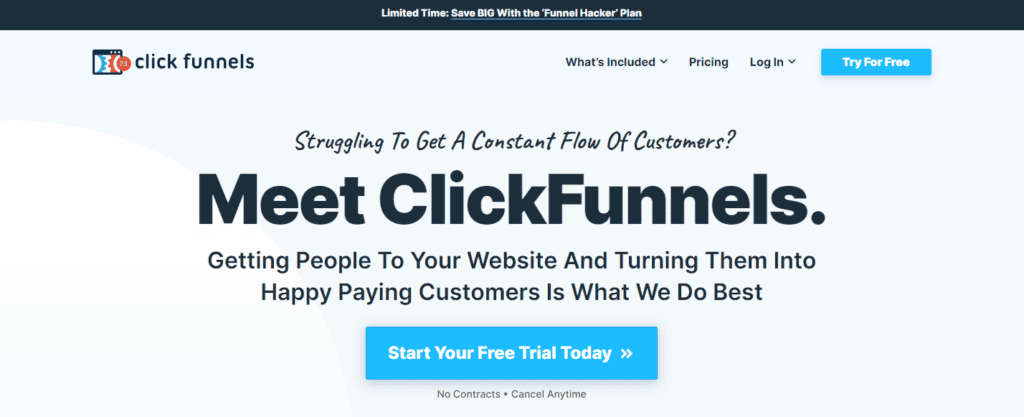
When it comes to marketing your business, there are many different tools and software available to help you achieve your goals. Two of the most popular options for creating and managing marketing funnels are ClickFunnels and ConvertKit. While both of these platforms have their own unique strengths and weaknesses, it can be difficult to determine which one is the best fit for your business needs.
We will explore the key features and benefits of each platform, as well as their limitations and potential drawbacks. So, let’s dive in and explore ClickFunnels vs ConvertKit.
ClickFunnels: Pros and Cons

When it comes to ClickFunnels, there are both pros and cons to consider. Here’s a breakdown of what we’ve found:
Pros
- Easy to use: ClickFunnels has a user-friendly interface that makes it easy to create and customize your sales funnels.
- All-in-one platform: ClickFunnels offers a wide range of features, including landing pages, sales pages, order forms, upsell pages, and more. This means you can manage your entire sales funnel in one place.
- Optimization tools: ClickFunnels provides a variety of optimization tools, such as A/B testing and conversion tracking, to help you improve your funnel’s performance.
- Integrations: ClickFunnels integrates with a variety of third-party tools, such as email marketing platforms, payment processors, and more.
Cons
- Expensive: ClickFunnels can be expensive, especially for small businesses or individuals just starting out.
- Limited customization: While ClickFunnels offers a range of templates and customization options, some users may find the platform limiting in terms of design and layout.
- Limited email marketing features: While ClickFunnels does offer some email marketing features, it’s not as robust as other dedicated email marketing platforms like ConvertKit.
Overall, ClickFunnels is a powerful tool for creating and managing sales funnels, but it may not be the best fit for everyone. It’s important to consider your business’s specific needs and goals before committing to any platform.
ConvertKit: Pros and Cons

ConvertKit is a marketing automation tool that specializes in email marketing and audience segmentation. Here are some of its pros and cons:
Pros
- User-friendly interface: ConvertKit has a simple and intuitive interface that makes it easy to navigate and use.
- Powerful automation features: ConvertKit offers advanced automation features that allow you to create complex automation workflows.
- Customizable landing pages: ConvertKit allows you to create custom landing pages that match your brand and convert visitors into subscribers.
- Easy integration with other tools: ConvertKit integrates with a wide range of tools, including WordPress, Shopify, and Zapier.
- Excellent customer support: ConvertKit offers excellent customer support, including a knowledge base, email support, and live chat.
Cons
- Limited design options: ConvertKit’s landing page editor is limited in terms of design options and customization.
- No visual workflow builder: ConvertKit’s automation features are powerful, but they lack a visual workflow builder, which can make it difficult to create complex automation workflows.
- Limited reporting: ConvertKit’s reporting features are limited, which can make it difficult to track the performance of your campaigns.
Overall, ConvertKit is a powerful email marketing tool that offers advanced automation features and excellent customer support. However, it has some limitations in terms of design options, and reporting.
ClickFunnels vs ConvertKit: Features Comparison
When deciding between ClickFunnels and ConvertKit, it’s important to consider the features each platform offers. Here’s a breakdown of the key features of each platform and how they compare:
Landing Page Builder
ClickFunnels is known for its powerful landing page builder, which allows users to create high-converting landing pages quickly and easily. The platform offers a wide variety of templates and customization options, making it easy to create landing pages that match your brand and convert visitors into customers.
ConvertKit, on the other hand, does not have a dedicated landing page builder. While it does offer customizable forms, it may not be the best choice for businesses that rely heavily on landing pages for lead generation and sales.
Ecommerce
ClickFunnels offers robust ecommerce features, including the ability to create sales funnels, process payments, and manage orders. The platform also integrates with a variety of third-party tools, making it easy to manage your entire ecommerce operation from one place.
ConvertKit does not have ecommerce features built-in, but it does integrate with a variety of ecommerce platforms, including Shopify and WooCommerce.
Email Marketing
ConvertKit is primarily an email marketing platform, and it offers a wide range of features to help businesses build and manage their email lists. The platform offers customizable forms, automation workflows, and detailed analytics to help businesses optimize their email marketing campaigns.
ClickFunnels also offers email marketing features, including the ability to create email sequences and send broadcast emails. However, its email marketing capabilities may not be as robust as those of ConvertKit.
Analytics
Both ClickFunnels and ConvertKit offer detailed analytics to help businesses track the performance of their marketing campaigns. ClickFunnels offers analytics on funnel performance, while ConvertKit offers analytics on email performance.
Ease of Use
When it comes to ease of use, both ClickFunnels and ConvertKit have their own strengths and weaknesses.
ClickFunnels prides itself on its user-friendly interface and intuitive drag-and-drop funnel builder. With pre-designed templates and easy-to-use editing tools, ClickFunnels aims to simplify the funnel creation process for beginners. However, the comprehensive features and customization options may result in a higher learning curve for beginners.
On the other hand, ConvertKit provides a simpler and more streamlined experience, making it accessible to marketers of all skill levels. The interface is straightforward and easy to navigate, and the email editor is simple and intuitive. However, ConvertKit’s limited customization options may not be suitable for businesses with more complex needs.
Pricing Comparison
When it comes to choosing the right platform for your business, pricing is an important factor to consider. Let’s take a closer look at the pricing structures of ClickFunnels and ConvertKit to determine which one offers better value for your money.
ClickFunnels offers three pricing plans: Basic, Pro, and Funnel Hacker. The Basic plan costs $127 per month, the Pro plan costs $157 per month, and the Funnel Hacker plan costs $208 per month. Each plan comes with a different set of features, and the more expensive plans include more advanced features.
On the other hand, ConvertKit offers a simpler pricing structure. The platform charges based on the number of subscribers you have on your email list. The pricing starts at $29 per month for up to 1,000 subscribers, and goes up to $79 per month for up to 5,000 subscribers. If you have more than 5,000 subscribers, you’ll need to contact ConvertKit for a custom quote.
Overall, if you’re just starting out and have a small email list, ConvertKit’s pricing is likely to be more affordable. However, if you’re looking for a more advanced platform with a wider range of features, ClickFunnels may be the better option.
Customer Support
When choosing a marketing platform, customer support is an important factor to consider. Both ClickFunnels and ConvertKit offer customer support, but there are some differences between the two.
ClickFunnels has a variety of support options available, including email support, live chat, and phone support. They also have a knowledge base with helpful articles and tutorials. However, some users have reported long wait times for customer support and difficulty getting their issues resolved.
ConvertKit also offers email support and a knowledge base, but they do not have live chat or phone support. However, their email support is known for being responsive and helpful, with most issues being resolved quickly.
Integration Capabilities
When considering which platform to use, it’s important to evaluate the integration capabilities of both ClickFunnels and ConvertKit.
ClickFunnels offers a wide range of integrations with various third-party tools, including payment gateways, email marketing services, and membership site platforms. Some of the most popular integrations include Stripe, PayPal, Mailchimp, and Aweber. Additionally, ClickFunnels offers a Zapier integration, which allows users to connect with even more apps and services.
On the other hand, ConvertKit is primarily focused on email marketing and offers integrations with a variety of tools to enhance this functionality. Some of the most popular integrations include Shopify, WooCommerce, and Teachable. ConvertKit also offers a Zapier integration, which allows users to connect with other apps and services.
User Reviews
After conducting research on both ClickFunnels and ConvertKit, we compiled a list of user reviews to help provide a better understanding of each platform. Here are some of the key takeaways:
- ClickFunnels users appreciate the ease of use and the ability to create high-converting sales funnels quickly.
- ConvertKit users praise the platform’s email marketing automation features and the ability to segment their audience effectively.
- Some users have reported issues with ClickFunnels’ customer support, while others have had positive experiences.
- ConvertKit users have mentioned that the platform’s interface can be confusing at times, but overall, they find it to be a powerful tool for their email marketing needs.
- Both platforms have received positive feedback for their integrations with other tools and services, making it easy for users to connect and automate their workflows.
Overall, user reviews suggest that both ClickFunnels and ConvertKit have their strengths and weaknesses, and choosing between the two will depend on the specific needs of your business.
Conclusion
Both ClickFunnels and ConvertKit offer a range of features and capabilities to enhance your online marketing efforts. The choice between the two ultimately depends on your specific needs and priorities.
If you primarily require a robust sales funnel builder with integrated email marketing, ClickFunnels might be the better option. It offers extensive customization options and excels in creating sales funnels. However, ClickFunnels can be more expensive than ConvertKit, and it may not be the best choice for businesses that primarily focus on email marketing.
On the other hand, ConvertKit is designed specifically for email marketing and offers a range of automation features. It is a more affordable option than ClickFunnels, and it may be the better choice for businesses that primarily focus on email marketing.
Frequently Asked Questions
What is the difference between ClickFunnels and ConvertKit?
ClickFunnels excels in creating sales funnels and optimizing conversions, while ConvertKit specializes in email marketing and audience segmentation. Depending on your business needs, you can choose the platform that best suits your goals and objectives.
How does ConvertKit pricing compare to ClickFunnels pricing?
ConvertKit offers a free plan for up to 1,000 subscribers, and its paid plans start at $29 per month for up to 1,000 subscribers. ClickFunnels, on the other hand, starts at $97 per month for its basic plan, which includes up to 20 funnels, 100 pages, and 20,000 visitors per month.
Does ConvertKit work with ClickFunnels?
Yes, ConvertKit can be integrated with ClickFunnels to automate email campaigns and deliver targeted content to subscribers.
